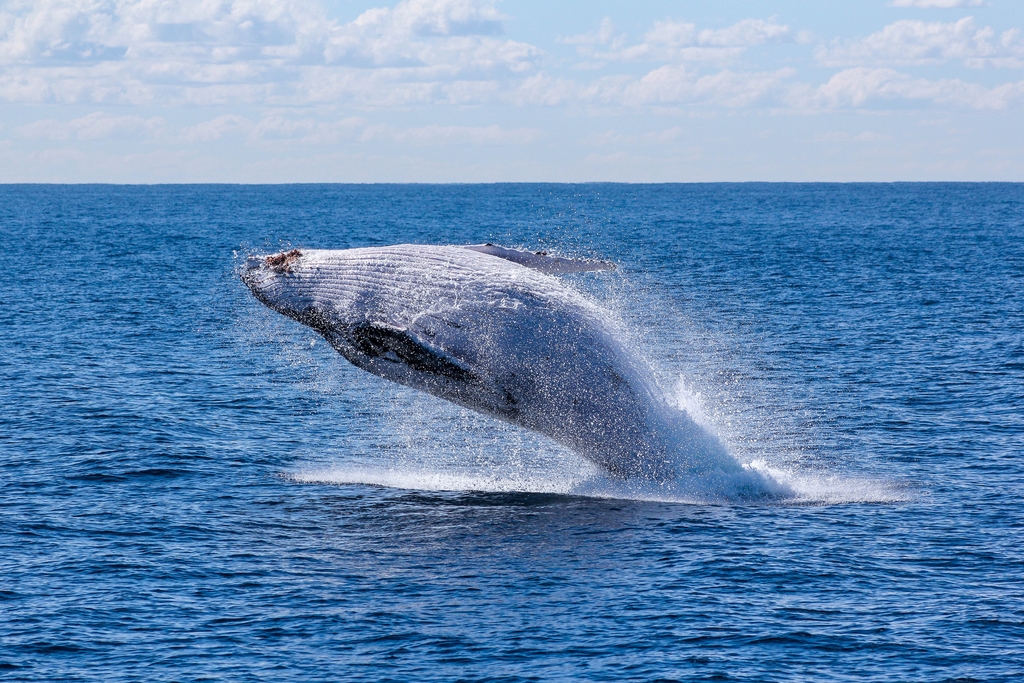Whale Tales: Blue Whale Genomes, Resilience to Genetic Bottleneck, and Interbreeding Insights
CGEn sat down with Mark Engstrom, Associate Professor at the University of Toronto and Deputy Director, Collections & Research at the Royal Ontario Museum (ROM), and Oliver Haddrath, Research Technician from the ROM to go behind the science with a special focus on the genomics work in their recent research paper that demystifies the blue whale genomes. This research garnered significant interest, including coverage in a New York Times article.

Image: North Atlantic blue whale, source: Earth.org
Blue whales, the largest animals, continue to captivate the scientific community with their enigmatic behaviours and ecological importance. Despite facing a century of industrial whaling that decimated their populations, new genomic research is painting a surprisingly resilient picture of these majestic creatures.
“One of the challenges early on was obtaining high-quality DNA from decomposed whale tissues”- Oliver Haddrath
The genesis of this pioneering study traces back to a poignant event in 2014 when nine blue whales perished after being trapped by ice near Newfoundland, Canada. Engstrom’s team was focused on whale conservation in Canada, particularly on the East Coast, and sought to model new data. They aimed to map the blue whale genome, which lacked an existing reference. Engstrom’s team used samples from the stranded whales and 26 others to conduct genomic analysis of the North Atlantic population. “One of the challenges early on was obtaining high-quality DNA from decomposed whale tissues. We finally devised strategies such as focusing on submerged parts of the remains for high-quality tissue.” Haddrath says.
Working with long-standing collaborators at CGEn-Toronto (The Centre for Applied Genomics (TCAG) at The Hospital for Sick Children) the samples were sequenced using a mix of long- and short-read technologies, partially supported through Canseq150, a CGEn and partners-driven initiative to sequence 150 new genomes for Canada’s 150th birthday.
Engstrom, Haddrath, and their team were faced with the challenging task of assembling the genome of the blue whale. Supported by TCAG they chose a de novo genome assembly approach. This method allowed them to build the genome without relying on a ‘template genome’ from a closely related species, minimizing the risk of missing unique blue whale genome features. Long-read sequencing, though less accurate and requiring more specialized infrastructure (PacBio Sequel), was essential for producing large sequence fragments that could be pieced together more easily. Complementary short-read sequencing produced more precise sequences to refine the constructed genome. To help researchers in the community, the authors made the blue whale genome publicly accessible.
The building of the blue whale genome might have been the end of a research project in itself but for the authors, it was the starting point towards answering their question. The collaborative effort yielded unprecedented findings, challenging conventional wisdom and shedding light on hidden aspects of blue whale demographics. Despite the severe impacts of historical whaling, genomic analysis found no signs of a genetic bottleneck, indicating the resilience of blue whales, possibly due to their slow reproductive rate, which offers hope for future survival. The study also revealed unexpected patterns of gene flow, contradicting traditional notions of east-west population divisions, with genetic evidence showing extensive intermingling in one direction—west to east—driven by ocean currents carrying whales and their prey, krill, across vast distances. Additionally, the research uncovered evidence of interspecies mating between blue whales and fin whales, tracing back approximately 3.5 percent of the blue whale genome to fin whales, challenging previous beliefs about hybrid sterility and raising questions about the functional significance of these genes in blue whale physiology.
You can’t conserve what you don’t know. This is why this information is so important.”- Mark Engstorm
The implications of these findings extend beyond scientific curiosity to inform conservation strategies crucial for the preservation of the blue whale population, which is currently estimated to be below 3,500.” You can’t conserve what you don’t know. This is why this information is so important.” explains Engstorm. Understanding whether there are distinct units or one metapopulation informs plans for conservation efforts across North American and European waters. The movement and intermixing of blue whales across the Atlantic provides a glimmer of hope for population recovery. However, the authors caution that while the (current) absence of a genetic bottleneck is promising, ongoing population decline could eventually lead to its emergence.
By linking natural history with genomic analysis, this work shows the value of collaboration and interdisciplinary approaches in unravelling nature’s puzzles and guiding conservation efforts in an ever-changing world. Engstorm, Haddrath, and their collaborators remain committed to pushing the boundaries of genomic research and leveraging their findings to advocate for the protection of blue whales. They hope to carry forward their research to study other populations of blue whales and look in more depth at the other player in this scenario- the fin whales.

